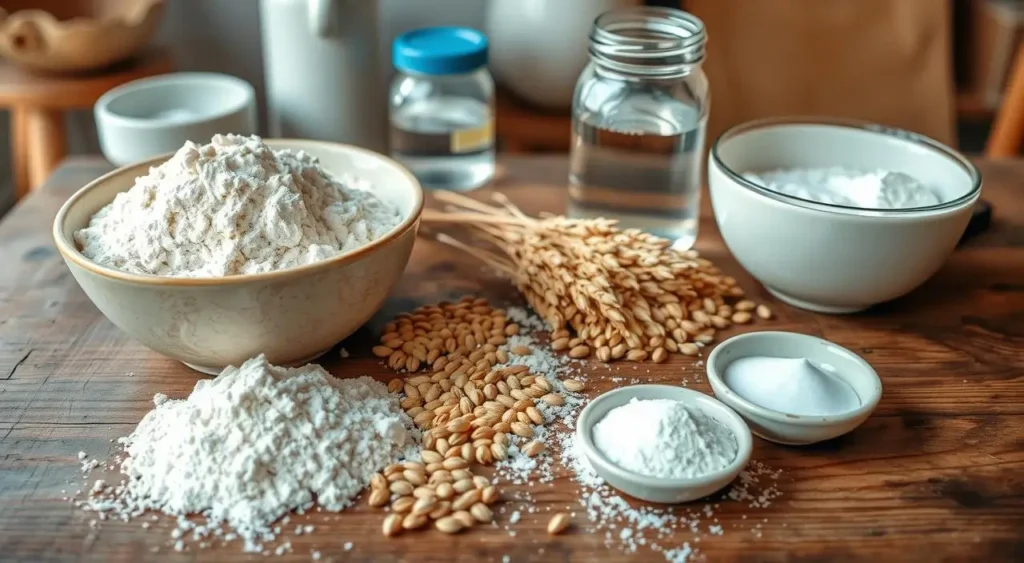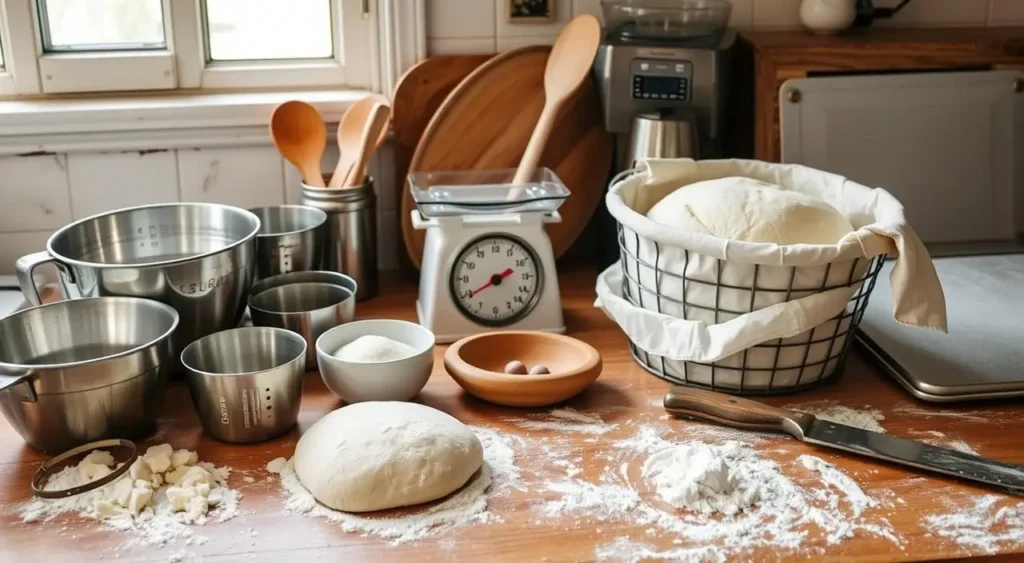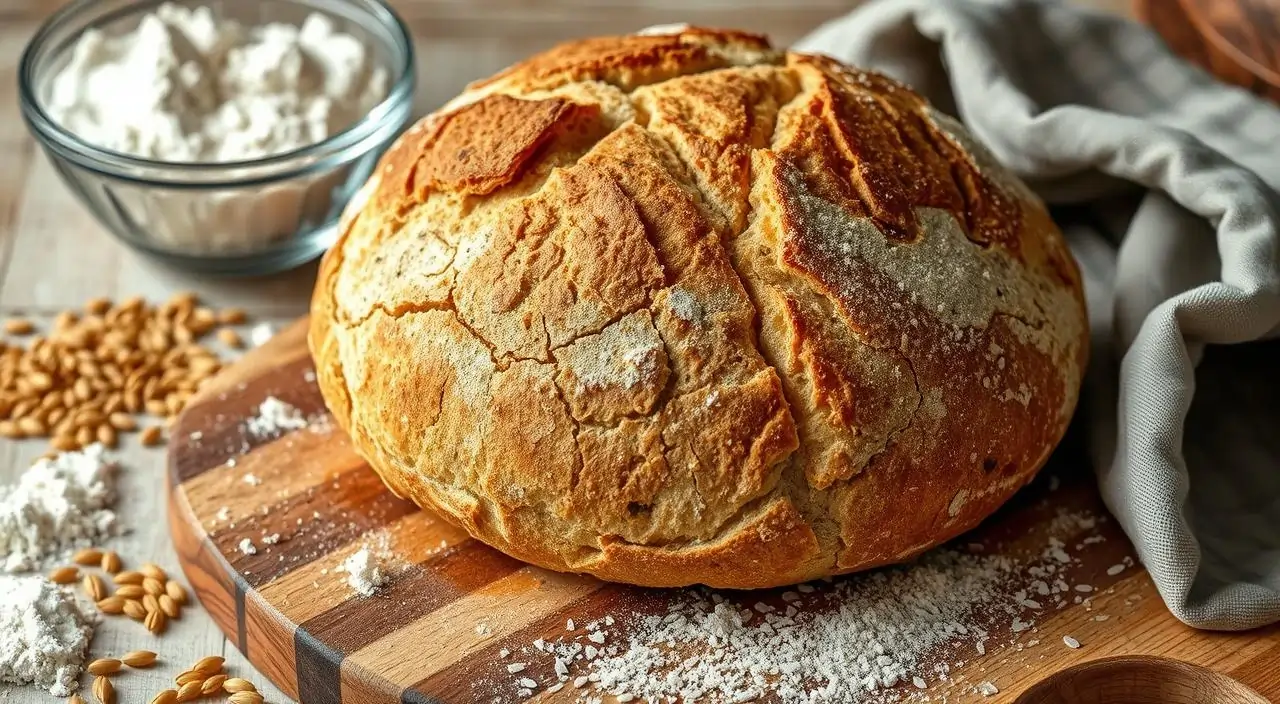I’ve always loved baking sourdough bread for its amazing taste and texture. But keeping a sourdough starter seemed too hard. That changed when I found a way to make sourdough without a starter. Get ready to learn about quick sourdough bread and discover a world of delicious flavors.
Table of Contents
Understanding Quick Sourdough Bread Basics
Exploring no yeast sourdough bread and sourdough without a starter is a fun baking journey. These new ways to make sourdough let you enjoy its great taste and texture. You don’t need to keep a starter culture.
What Makes Sourdough Different
Sourdough bread is special because of its unique taste and texture. It’s made differently than regular bread, using wild yeasts and bacteria. This gives it a tangy flavor and a chewy, open crumb.
The Science Behind No-Starter Methods
Traditional sourdough needs a starter, but the no-starter method is different. It uses acidic ingredients like yogurt or vinegar. These add a tangy taste and help the dough rise.
Benefits of Making Starter-Free Sourdough
- Less prep time: No starter means quicker baking, which is perfect for those who are busy.
- More flexibility: You can make sourdough whenever you want without keeping a starter.
- Consistent results: These methods give you reliable, tasty bread every time.

Trying no yeast sourdough bread and sourdough without a starter opens up new flavors and textures. It makes sourdough baking easier and more flexible.
Essential Ingredients for No-Starter Sourdough Bread
Making sourdough bread without a starter is easy. The key is choosing the right ingredients. These will give your bread the flavor and texture of real sourdough. Let’s explore the must-haves for a quick sourdough bread that’s sure to impress.
The heart of your recipe is the flour. Use bread flour or a mix of whole wheat and all-purpose for a richer taste. Bread flour’s high protein content makes the bread chewy and crusty.
To get the sourdough tang, add an acidic ingredient. Instant yeast or quick sourdough bread mixes help it rise. Yogurt, buttermilk, or lemon juice add the sourness you want.
- Bread flour or a blend of whole wheat and all-purpose flour
- Instant yeast or quick sourdough bread mix
- Acidic ingredients like yogurt, buttermilk, or lemon juice
- Salt to enhance flavor
- Water to bring the dough together
With these ingredients, you’re set to bake a delicious sourdough bread. Impress your loved ones with the amazing smell and taste of your homemade sourdough bread and instant yeast creations.

“Sourdough bread is the ultimate comfort food, and with these simple ingredients, you can enjoy its satisfying texture and tangy flavor any time.”
Required Kitchen Tools and Equipment
Baking sourdough bread without a starter can be challenging. But, with the right tools and equipment, you can make delicious bread. Whether you’re new to baking or experienced, knowing the essential tools and environmental factors is key.
Basic Tools Needed
- Mixing bowl: A large, sturdy bowl for mixing the dough.
- Dough scraper: A handy tool for handling the dough and transferring it to the baking surface.
- Bench scraper: Used for cutting and shaping the dough, as well as cleaning the work surface.
- Bread lame or sharp knife: For scoring the surface of the dough before baking.
- Baking sheet or Dutch oven: The surface where the dough will be baked.
- Parchment paper: Helps prevent the dough from sticking to the baking surface.
Optional Equipment for Better Results
While basic tools are crucial, some optional equipment can improve your baking experience:
- Stand mixer: Simplifies the kneading process and can help develop the gluten structure.
- Bread proofing basket (banneton): Helps shape and proof the dough, resulting in a better rise and crust.
- Steaming tray or cast-iron pan: Adding steam to the oven can create a beautiful, crispy crust.
- Thermometer: Ensuring the optimal temperature for proofing and baking is crucial for consistent results.
Temperature and Environment Considerations
The temperature and environment where you bake can greatly affect your bread. Aim for a warm environment (around 75°F to 85°F) for the dough to ferment and proof properly. Avoid drafty areas or significant temperature changes, as they can disrupt the rising and baking process.

Quick Sourdough Bread Preparation Steps
Making quick sourdough bread without a starter might seem hard. But with the right steps, you can make delicious bread. Here’s how to start:
- Gather your ingredients: flour, water, salt, and sourdough bread instant yeast. Measure them carefully for a consistent dough.
- In a large mixing bowl, mix flour and salt. Make a well and add water and quick sourdough bread yeast. Mix until a shaggy dough forms.
- Turn the dough onto a floured surface and knead for 10 minutes. It should be smooth and elastic. This step is key for the bread’s texture.
- Put the dough in a lightly oiled bowl, cover it, and let it ferment at room temperature for 8-12 hours. This step lets the yeast work its magic and create the flavor you want.
By following these simple steps, you can enjoy the taste of sourdough bread without a traditional starter. Get ready to enjoy the aroma and texture of your homemade quick sourdough bread!
Mixing and Kneading Techniques
Making the perfect sourdough bread without a starter or no yeast sourdough bread needs a mix of mixing and kneading. You can choose to knead by hand or use a stand mixer. Knowing how to work the dough is crucial for a chewy texture and rich flavor.
Hand Kneading for a Hands-On Experience
Hand kneading is a calming process. Start by folding the dough over itself gently. Then, push and stretch it away from you with the heel of your hand. Turn the dough a quarter turn and repeat for 8-10 minutes. This makes the dough smooth and elastic.
Streamlining with a Stand Mixer
Using a stand mixer can make things easier for sourdough bread without a starter. With the dough hook attachment, mix on medium-low speed for 5-7 minutes. The dough should be a cohesive, slightly tacky ball. Watch the time to avoid a dense, tough bread.
Recognizing Visual Cues for Perfect Dough
- The dough should pass the “windowpane test,” where a small piece can be stretched thin without tearing.
- When poked, the dough should bounce back slowly, indicating proper gluten development.
- The dough should be smooth and slightly tacky to the touch, not dry or overly sticky.
Mastering these techniques will help you make sourdough bread without a starter. Your bread will look great and taste amazing.
Fermentation and Proofing Guide
Making the perfect quick sourdough bread or sourdough bread without starter needs a balance. This balance is in fermentation and proofing. It’s where your dough gets its flavor, texture, and rise. Knowing the best conditions for this stage is crucial.
Fermentation lets the dough’s yeasts and bacteria work. They break down starches and proteins, giving sourdough its tang. Keep the temperature right, between 70-85°F (21-29°C), to help this process.
- Let your dough ferment for 6-12 hours. The time depends on temperature and flavor you want. Longer fermentation means a stronger sourdough taste.
- To see if it’s ready, do a float test. Drop a small dough piece into water. If it floats, it’s time for the next step.
The proofing stage is when your dough rises for the last time. This makes it light and airy. Keep it warm and draft-free, around 75-85°F (24-29°C), for the best results.
- Proof your dough for 1-2 hours. It should double in size and feel light.
- Don’t over-proof. This can make your bread dense or collapsed.
| Fermentation Temperature | Fermentation Time | Proofing Temperature | Proofing Time |
|---|---|---|---|
| 70-85°F (21-29°C) | 6-12 hours | 75-85°F (24-29°C) | 1-2 hours |
Mastering fermentation and proofing will help you make quick sourdough bread or sourdough bread without starter. Your bread will be tasty and look great.
Creating the Perfect Sourdough Flavor Without Starter
You don’t need a traditional starter to get that sourdough taste. There are natural ways to get that unique flavor without a long fermentation time.
Natural Acidic Ingredients
Using acidic ingredients can mimic sourdough’s tangy taste. Here are some options:
- Buttermilk or plain yogurt: These add a subtle sourness and tenderness.
- Lemon juice or apple cider vinegar: A small amount can give the desired sourdough taste.
- Whole wheat or rye flour: These flours add acidity and nutty flavors.
Flavor Enhancement Methods
There are other ways to boost sourdough flavor without a starter:
- Extended fermentation: Longer fermentation time develops more complex flavors.
- Delayed baking: Longer proofing before baking enhances sourdough qualities.
- Frequent folding: Folding the dough improves texture and flavor.
Using these ingredients and methods, you can get sourdough flavor without a starter. Try different combinations to find the perfect tang in your sourdough bread without a starter and sourdough bread instant yeast.
Shaping Your Sourdough Bread
Learning to shape your no-yeast sourdough bread is key to a perfect loaf. The way you shape it affects its look, feel, and quality. With the right techniques, you can make loaves that look like they came from a bakery.
Shaping Methods for No-Starter Sourdough
There are several ways to shape your no-yeast sourdough bread. The most common include:
- Simple Boule (Round Loaf) – Gather the dough into a smooth, round shape. Tuck the edges under for a tight surface.
- Batard (Oblong Loaf) – Stretch and shape the dough into an oval. Taper the ends for a French-style loaf.
- Baguette – Roll and stretch the dough into a long, thin cylinder. This creates a traditional baguette shape.
When shaping, handle the dough gently. Avoid overworking or degassing the air pockets that form during fermentation.
Shaping Techniques for Better Texture
There are techniques to improve your sourdough bread’s texture and look:
- Bench Shaping – Flour your work surface and stretch and fold the dough. This creates surface tension for a tighter shape.
- Couche Proofing – Proof the shaped dough in a linen-lined basket or on a couche. This helps keep the shape and develops a beautiful crust.
- Scoring – Score the dough’s top with a sharp knife or lame before baking. This allows the bread to expand and create “ears” and a crisp crust.
Try different shaping methods and techniques to improve your no yeast sourdough bread. You can make stunning, bakery-quality loaves at home.
Scoring Patterns and Techniques
Improving the look of your sourdough bread without a starter is key. Learning to score the dough is essential. Scoring not only makes the bread look better but also helps it expand properly while baking.
Basic Scoring Designs
Whether you’re new or experienced, there are many basic scoring patterns to try. These can add a lot of visual interest to your sourdough bread without starter. Here are some favorites:
- The classic single-slash or “bread score.”
- Parallel lines creating a tic-tac-toe-like pattern
- Concentric circles radiating outward from the centre
- Diagonal or criss-cross lines, forming a diamond or lattice design
Professional Scoring Tips
For a more polished look, try these advanced scoring techniques:
- Use a sharp, preferably serrated lame or bread-scoring knife to create clean, precise cuts.
- Angle the blade slightly (30-45 degrees) for deeper, more controlled scores.
- Make swift, confident strokes, avoiding hesitation or sawing motions.
- Experiment with different depths and patterns to find your preferred aesthetic.
- Utilize visual cues, such as the rise and tension of the dough, to guide your scoring decisions.
Getting good at scoring can make your sourdough bread without a starter look like it came from a bakery. With practice, you’ll be able to make loaves that look amazing.
Baking Temperature and Timing
To make the perfect quick sourdough bread or sourdough bread instant yeast, pay close attention to baking temperature and timing. These are key to getting the right crust and crumb for your homemade loaf.
First, heat your oven to 450°F to 500°F (232°C to 260°C). This high heat causes the dough to rise quickly in the first few minutes. It also starts the Maillard reaction, which makes the crust golden brown.
- Bake your quick sourdough bread or sourdough bread instant yeast at this high temperature for 15-20 minutes.
- Then, lower the oven to 400°F (204°C) and bake for another 20-30 minutes. Keep baking until the crust is dark and the inside is 205°F to 210°F (96°C to 99°C).
- If your bread browns too fast, cover it with foil. This stops it from getting too dark while it finishes baking.
Remember, baking times and temperatures can change based on your oven and loaf size. Watch your bread closely and adjust as needed. This will help you get a crust that’s both crisp and golden, and a crumb that’s soft and open.
| Baking Stage | Temperature | Time |
|---|---|---|
| Initial Bake | 450°F to 500°F (232°C to 260°C) | 15-20 minutes |
| Continued Baking | 400°F (204°C) | 20-30 minutes |
By following these baking temperature and timing tips, you’ll be on your way to making a delicious quick sourdough bread or sourdough bread instant yeast. Experiment and adjust to find the best baking method for your homemade sourdough loaf.
Achieving the Perfect Crust and Crumb
Making sourdough bread without a starter is a fun challenge. Learning how to get the perfect crust and crumb is key. By understanding the science behind these elements, you can bake sourdough bread to perfection, even without a starter.
Crust Development Techniques
The crust of your sourdough bread is the first thing people notice. It also affects the bread’s texture and taste. To get a crisp, golden-brown crust, try these techniques:
- Preheat your oven with a baking stone or Dutch oven. This creates a hot, humid environment that helps the crust form.
- Mist the dough with water or use a steam injection method during the initial baking stage. This helps the crust develop and expand.
- Brush the dough with an egg wash or milk before baking. This will give you a shiny, caramelized crust.
Creating Open Crumb Structure
The open crumb structure is a key feature of great sourdough bread. It has large, irregular air pockets. To achieve this without a traditional starter, focus on the following:
- Watch the dough’s fermentation closely. Make sure it proofs enough before baking.
- Use gentle folding and stretching during the rise. This helps develop the gluten and creates air pockets.
- Try a higher hydration dough. This can make the crumb more open and airy.
Getting perfect sourdough without a starter might take some trial and error. But with the right techniques and patience, you can make a truly amazing loaf of sourdough without starter or no yeast sourdough bread.
Common Issues and Troubleshooting
Making a tasty sourdough bread without starter is rewarding but comes with challenges. As you start your quick sourdough bread adventure, you’ll face some common problems. Learning how to fix them will help you succeed.
Dense Crumb? Adjust Your Kneading Technique
If your sourdough bread has a dense crumb, kneading might be the issue. Knead the dough well, by hand or with a mixer, until it’s smooth and elastic. Look for signs like the dough passing the “windowpane test” to know it’s ready.
Lack of Rise? Revisit Your Proofing Process
A flat rise might mean the dough didn’t proof enough. Check your proofing times and conditions. Make sure the dough has enough time to ferment and get those air pockets. Try longer proofing or a warmer spot for better rise.
Bland Flavor? Enhance with Natural Ingredients
If your sourdough bread tastes bland, try adding natural acids. Use buttermilk, yogurt, or apple cider vinegar. These can add the tangy flavors you’re looking for.
| Common Issue | Possible Cause | Troubleshooting Tip |
|---|---|---|
| Dense Crumb | Insufficient Kneading | Knead the dough thoroughly until it becomes smooth and elastic |
| Lack of Rise | Underperfed Dough | Adjust proofing time and environment to encourage fermentation |
| Bland Flavor | Lack of Natural Acidity | Incorporate acidic ingredients like buttermilk, yogurt, or apple cider vinegar |
Every sourdough bread baking journey is different. It takes time and practice to master. By tackling these common issues and using these tips, you’ll make great quick sourdough bread without a starter.
Storage and Preservation Methods
Keeping your homemade sourdough bread fresh is key. Whether you’re eating it now or freezing it for later, there are good ways to do it. These methods help your sourdough stay delicious and fresh.
Short-term Storage Solutions
For a few days, store your sourdough at room temperature. Wrap it in a clean, dry towel or a paper bag. Don’t use plastic bags, as they can make the crust soft. Your sourdough will stay fresh for 3-4 days this way.
Freezing and Thawing Tips
To make your sourdough without a starter last longer, freeze it. Slice the loaf and freeze the slices on a baking sheet. Then, put them in an airtight container or bag. This keeps your sourdough bread instant yeast good for 3 months.
When you want to eat it, just thaw the slices at room temperature. They’ll be ready to enjoy.

